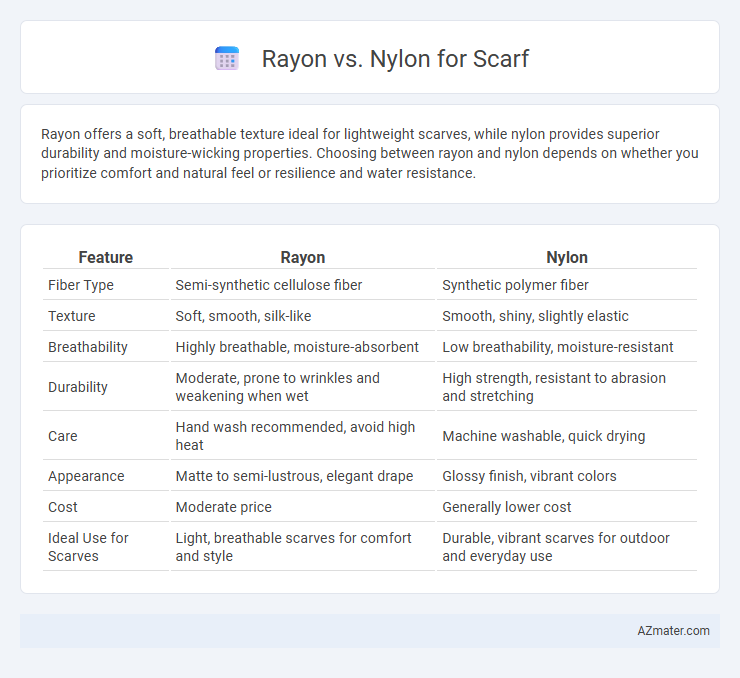Rayon offers a soft, breathable texture ideal for lightweight scarves, while nylon provides superior durability and moisture-wicking properties. Choosing between rayon and nylon depends on whether you prioritize comfort and natural feel or resilience and water resistance.
Table of Comparison
| Feature | Rayon | Nylon |
|---|---|---|
| Fiber Type | Semi-synthetic cellulose fiber | Synthetic polymer fiber |
| Texture | Soft, smooth, silk-like | Smooth, shiny, slightly elastic |
| Breathability | Highly breathable, moisture-absorbent | Low breathability, moisture-resistant |
| Durability | Moderate, prone to wrinkles and weakening when wet | High strength, resistant to abrasion and stretching |
| Care | Hand wash recommended, avoid high heat | Machine washable, quick drying |
| Appearance | Matte to semi-lustrous, elegant drape | Glossy finish, vibrant colors |
| Cost | Moderate price | Generally lower cost |
| Ideal Use for Scarves | Light, breathable scarves for comfort and style | Durable, vibrant scarves for outdoor and everyday use |
Introduction to Rayon and Nylon
Rayon is a semi-synthetic fiber made from cellulose derived from wood pulp, known for its softness, breathability, and silky texture, making it ideal for lightweight scarves. Nylon, a synthetic polymer created through petrochemical processes, offers exceptional durability, elasticity, and resistance to moisture, providing long-lasting performance in scarves. Both fibers offer distinct benefits, with rayon excelling in comfort and drape, while nylon stands out for strength and resilience in scarf materials.
Composition and Manufacturing Process
Rayon, a semi-synthetic fiber derived from cellulose found in wood pulp, undergoes a chemical process called regeneration to transform natural materials into soft, breathable fabric ideal for scarves. Nylon is a fully synthetic polymer made through the polymerization of petrochemical derivatives, featuring strong, elastic fibers created via melt spinning that offers durability and resistance to abrasion. The manufacturing process of rayon involves dissolving cellulose and regenerating it into fibers, while nylon is produced through synthetic polymerization and extrusion, resulting in distinct textures and performance characteristics.
Texture and Softness Comparison
Rayon scarves offer a smooth, silky texture that feels lightweight and breathable against the skin, making them ideal for sensitive or warm-weather wear. Nylon scarves tend to have a slightly stiffer texture with less natural softness, though they provide excellent durability and resistance to wrinkles. Overall, rayon excels in softness and comfort, while nylon prioritizes strength and shape retention.
Durability and Strength
Nylon offers superior durability and strength compared to rayon, making it more resistant to wear and tear in scarves. Rayon, while soft and breathable, tends to be weaker and more prone to stretching or shrinking over time. For long-lasting scarves that maintain their shape and integrity, nylon is the preferred fiber.
Moisture Absorption and Breathability
Rayon excels in moisture absorption, making it highly effective for scarves that need to wick sweat away from the skin, enhancing comfort during warm weather. Nylon, while durable and lightweight, has lower moisture absorption and tends to retain heat, which can result in less breathability. For scarves prioritizing breathability and moisture management, rayon offers superior natural fiber qualities compared to synthetic nylon.
Comfort and Wearability
Rayon offers superior breathability and softness, making it ideal for scarf comfort, especially in warmer climates, while nylon provides exceptional durability and elasticity, enhancing wearability and resistance to wrinkles. Rayon's moisture-absorbing properties keep the skin dry and comfortable, whereas nylon's lightweight synthetic fibers ensure long-lasting shape retention and easy maintenance. Choosing between rayon and nylon depends on whether priority is given to natural feel and comfort or to strength and resilience for daily use.
Color Retention and Dyeability
Rayon offers superior dyeability due to its cellulose-based fibers, allowing scarves to achieve vibrant, rich colors that retain well over time with proper care. Nylon, being synthetic, may not absorb dyes as deeply, resulting in colors that can fade faster when exposed to sunlight or frequent washing. For long-lasting, vivid scarf colors, rayon typically provides better color retention and more extensive dye options compared to nylon.
Maintenance and Care Tips
Rayon scarves require gentle hand washing with cold water to prevent fabric weakening and avoid shrinkage, while nylon scarves offer greater durability and can usually be machine washed on a delicate cycle without damage. To maintain rayon's softness and drape, avoid wringing and always air dry flat, whereas nylon benefits from quick drying and resists wrinkles, making it easier to maintain its smooth texture. Storing both rayon and nylon scarves away from direct sunlight extends color retention, but nylon's higher resistance to mildew makes it ideal for humid environments.
Environmental Impact and Sustainability
Rayon production involves chemical-intensive processes and heavy water use, leading to significant environmental pollution and deforestation due to wood pulp sourcing. Nylon, derived from petrochemicals, relies on non-renewable resources and contributes to greenhouse gas emissions and microplastic pollution during washing. Choosing scarves made from sustainable rayon alternatives, like lyocell, or recycled nylon helps reduce ecological footprints and promotes responsible fashion.
Best Choice for Scarves: Rayon or Nylon?
Rayon offers a soft, breathable texture with excellent drape, making it ideal for lightweight, comfortable scarves that feel gentle on the skin. Nylon, known for its durability and resistance to wrinkles and moisture, provides long-lasting scarves that maintain their shape and color even with frequent use. Choosing between rayon and nylon depends on whether the priority is on softness and breathability, favoring rayon, or on strength and resilience, favoring nylon for scarf material.

Infographic: Rayon vs Nylon for Scarf
 azmater.com
azmater.com